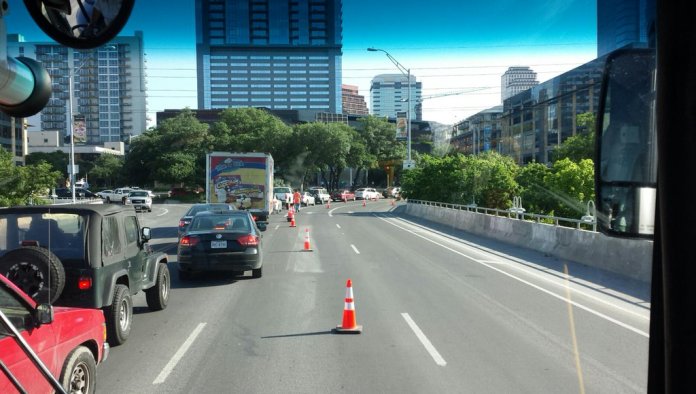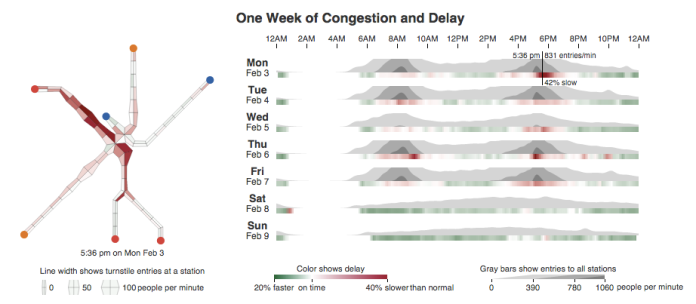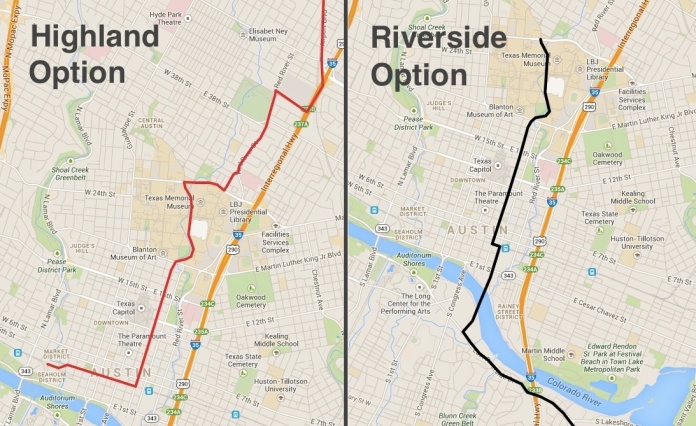
With the launch of MetroRapid quickly approaching, I wanted to share my thoughts on what I anticipate will be Capital Metro’s most successful project over the past decade. Starting on January 26th, Austinites will be able to ride new accordion-style buses from South Congress, through downtown, past UT and up North Lamar (Route 801). Later this year, a second route will be launched that travels from South Lamar, through downtown, past UT and up Burnet Road (Route 803). These new buses and the infrastructure supporting them are Capital Metro’s first attempt at what is referred to by transit planners as Bus Rapid Transit (BRT). BRT originated in Curitiba, Brazil in 1974 and has since spread across the world as an alternative to rail transit investments. The goal of BRT, especially in US markets, is to make riders feel that the system is more than “just regular bus service” by providing faster, more frequent, and higher quality service.
MetroRapid Features

One of the most important features of a BRT system is the allocation of dedicated transit lanes. With the launch of MetroRapid, buses will travel along transit priority lanes through downtown. Automobiles will still be allowed to enter this lane to make right turns, but it will certainly help make Austin’s transit system more reliable by giving buses the ability to bypass what is now chronic downtown congestion.
The new MetroRapid vehicles come with added features. Those accordion-style buses don’t just look cool, they will also be able to carry more people than regular local buses. This will hopefully mean a seat for everyone, which is a welcome change to the often overcrowded Route 1M/1L buses. These vehicles will also have multi-door boarding, which will help reduce dwell times at stations.
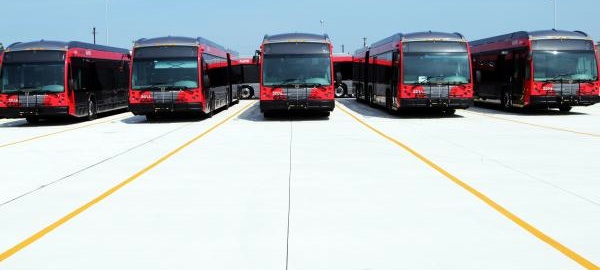
Another important feature that MetroRapid will have is bus signal prioritization outside of downtown. MetroRapid vehicles will have the ability to communicate with stop lights, allowing for extended green lights. This will help delayed vehicles catch up to meet their scheduled arrival and departure times.
While I am concerned with Route 801’s frequency (of which I will discuss later on in this post), riders on Route 803 will see the amount of time they will have to wait at the bus stop cut in half. These ten minute headways will give riders freedom from bus schedules by allowing them to show up to the stop whenever they want with the promise that a bus will soon arrive.
The MetroRapid feature that I am most excited for is the release of real-time transit information. Riders will soon have the ability to know exactly how far away their bus is. The information will be displayed not only at each station, but will also be accessible on mobile devices. As a side note, I believe this will be a good leverage point for those wanting Capital Metro to officially adopt an open data policy. Real-time transit data provides Capital Metro with great opportunity to open up their data so that third party developers can come up with new and innovative applications.
I strongly believe that all of these features, combined with clear and attractive branding, will help encourage more people to take advantage of transit in Austin.
Is MetroRapid BRT?

There has been a lot of discussion in Austin about whether or not MetroRapid even qualifies as BRT. During discussions like these, it’s important to keep in mind that there is not one single feature that defines BRT. What makes a bus system qualify as BRT, rather, is the quality and combination of a few key features. In order to help define BRT, the Institute for Transportation and Development Policy (ITDP) created The BRT Standard. According to ITDP’s BRT Standard and my fairly generous scoring, MetroRapid qualifies as “basic” BRT by scoring a 46/100. So MetroRapid is not “just regular bus service”, but there is clearly room for improvement if we want this system to achieve a Bronze, Silver or Gold BRT rating.
Future Improvements
So what specifically can Capital Metro & the City of Austin do to improve MetroRapid in the future?
Expand Dedicated Lanes
First, we should expand the amount of dedicated lanes we are giving to MetroRapid vehicles. The transit priority lanes are a great start, but we should really be looking to implement this tool where it matters most; on Austin’s congestion chokepoints. One of the City of Austin Transportation Department’s main goals for high-capacity transit is to break through what they refer to as the “Ring of Congestion”. This “Ring of Congestion” encompasses Lady Bird Lake to the South, I-35 to the East, the University of Texas to the North, and Mopac to the West. These barriers essentially funnel traffic destined for downtown onto a few key streets. This creates a transportation situation where no one wins and everyone loses.
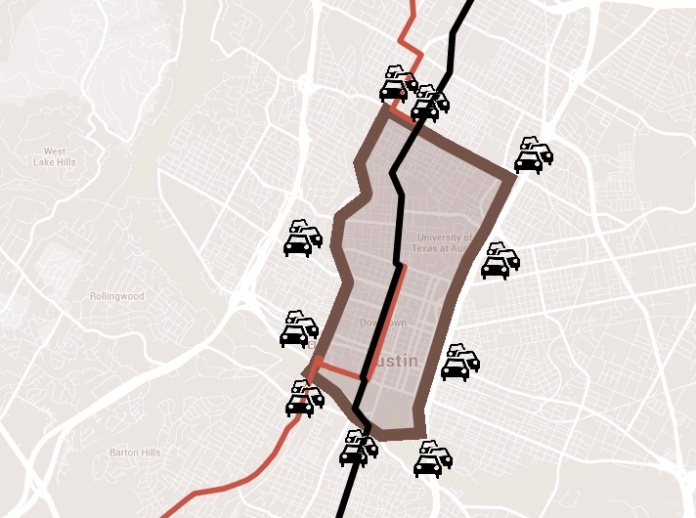
According to Jarrett Walker, “if you’re trying to create a transit advantage over a wide area of the city, it may well make sense to have a segment of exclusive transit right-of-way that gets you through a chokepoint”. Because city staff and politicians seem wary of taking any more room away from automobiles, transit advocates should do their part by giving them political cover for expanding dedicated lanes where it can make the biggest impact on transit reliability.
Increase Frequency on North Lamar & South Congress

As I shared earlier, one of the things that concerns me most about MetroRapid is that many of today’s Route 1M/1L riders will actually end up losing frequency. Mike Dahmus is right: While the 10 minute headways on Route 803 will be a great improvement over existing levels of service (riders on South Lamar and Burnet Road will see headways cut in half), most riders along Route 801 will actually be losing frequency. This bares repeating: With the launch of MetroRapid later this month, transit riders on our city’s highest ridership route that live outside of the urban core (i.e., South of Cesar Chavez and North of 38th Street) will see a decrease in frequency over existing conditions. Riders who are traveling between Cesar Chavez and 38th Street will see a an increase in service due to duplicate service. When I asked Project Connect staff about this issue at last month’s Urban Transportation Commission meeting, they shrugged it off as negligible. As transit advocates, we should be asking these hard questions and pressing Capital Metro to increase the frequency levels on Route 801 (or on the new consolidated Route 1).
Improve Walkability and Access
As a member of both the City of Austin Urban Transportation Commission and Capital Metro’s Customer Satisfaction Advisory Committee, I have a unique window into the way transit issues fit into the broader multi-modal picture. I always try to ground myself in the transit rider’s perspective. Some of the people I have talked to about MetroRapid are worried about the distance between MetroRapid stations. In transit planning, what many people view as a feature could also end up being a bug for some. While I’m against adding MetroRapid stations to the planned routes, I strongly believe we need to be making walkability improvements between and to MetroRapid stations. Capital Metro’s Customer Satisfaction Advisory Committee has already passed a resolution on this issue. I encourage the City of Austin and Capital Metro to work together to address this issue as soon as possible.
Addressing these three big issues will have a huge impact on the future success of the MetroRapid system.
Expanding MetroRapid
Austin’s transit community should be identifying immediate opportunities to expand MetroRapid to other corridors. In 2010, Capital Metro’s 10-year roadmap, Service Plan 2020, designated three MetroRapid corridors; South Congress to North Lamar, South Lamar to Burnet Road, and East Riverside to the Mueller Redevelopment. Why did the East Riverside to Mueller corridor get left out of the initial MetroRapid FTA grant? Was it because Capital Metro already had plans underway with the City of Austin to propose an urban rail alignment there? What is more plausible is that Capital Metro likely chose to move forward with the other two corridors (South Congress to North Lamar and South Lamar to Burnet Road) because they believed those two were the most competitive in receiving an FTA grant. After all, according to Capital Metro, “these two transit corridors see 21,000 weekday boardings…making them the densest and highest ridership transit markets in the region.”

At the end of last year, Project Connect identified East Riverside and Highland/Mueller as the priority high-capacity transit corridors. Many people believe the next high-capacity transit investment will be in the form of urban rail. One of the stated reasons for not considering Lamar for urban rail was that MetroRapid would serve as a test as to the viability of further investments there. If this is really a policy direction we want to take (not necessarily a bad one, in my opinion), shouldn’t we hold all other corridors to this same standard, including East Riverside and Highland/Mueller? If Capital Metro thought Lamar and the other corridors that will be served by MetroRapid were more competitive for a bus-based FTA Grant in 2012, why do they think a route to Highland/Mueller is the most competitive for a rail-based FTA Grant in 2014? Many people, including myself, have written about their concern over a speculative urban rail investment to Highland/Mueller. In keeping with Capital Metro’s Service Plan 2020, we should be advocating that the next MetroRapid investment connect East Riverside and Mueller to downtown.
Moving Forward
Overall, I am cautiously optimistic about the launch of MetroRapid and believe it will encourage many more people to take transit in Austin. I hope MetroRapid’s success will help the Austin transit community get past its obsession with mode (rail) and begin having clear-headed conversations about what really makes a great transit system. Jarrett Walker has written extensively about the bus vs rail issue on his blog, Human Transit.
To sum up my thoughts on MetroRapid, I believe Capital Metro and the City of Austin should be commended for their work and collaboration on this project over the past three years. In 2010, Capital Metro chose to make new investments in their most productive transit corridors. A few months ago, the City of Austin took away parking to establish bus priority lanes through downtown. These are the types of smart policies the transit community should be praising. That said, we can and should aspire for more improvements to this rather mediocre-scoring system. Let’s continue measuring MetroRapid’s success and advocating for improvements that will one day give it a Bronze, Silver or Gold BRT rating.


